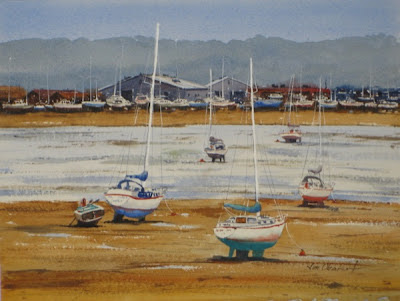One method to recover the white paper is to use a common household cleaning product - Original Mr. Clean Magic Eraser. This is a white foam pad, available in many grocery and hardware stores, intended for household cleaning chores. It is also great at removing watercolor paint. This "original" type contains no chemicals, and works through the physical design of the pad. Other "enhanced" versions do contain chemicals, and should not be used on watercolor paintings.
A piece of Magic Eraser is shown in the accompanying photo, which also shows the steps to be followed. After the paint is completely dry (1), mask around the area to be "cleaned" with masking tape, making sure that the tape edges are snug against the paper (2). Next, dip the Magic Eraser in water and squeeze it out so it is damp. Then gently rub over the area to be whitened. The small bits that you'll find are not pieces of your paper, but pieces of the pad. Dry the area. If it's not white enough, repeat the process until you are satisfied. Then simply remove the tape, and you have your "recovered" white paper, which can be painted over without problems (3).
I find this method especially useful for creating white sailboat masts against an already painted background. I feel that painting around white areas is the best approach, but this method is very useful when I realize that I need a white area after most of the painting has been completed. I recommend that this be used mainly for small areas, but it is possible to use it for large areas as well. You may want to watch this video which shows how I used it to modify a very large area of a painting:




